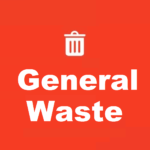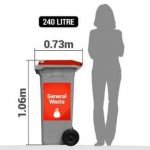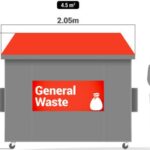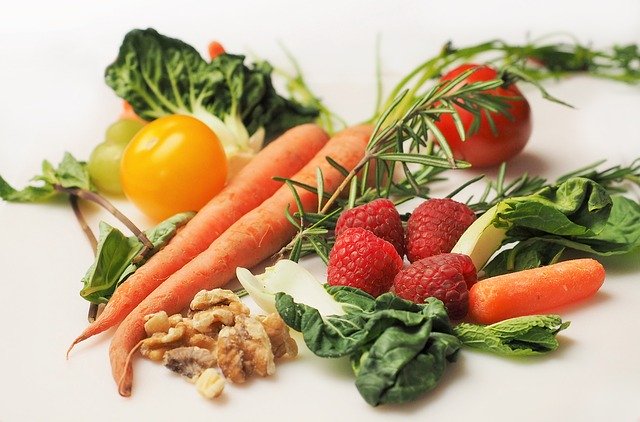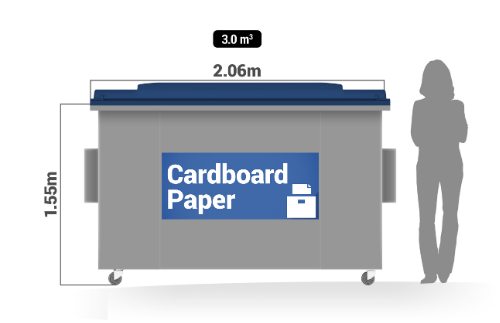Wheelie Bin Sizes Australia 2020 🗑️: What Is The Right Size For Your Business?
Energy Disrupter
Wheelie bin sizes Australia: We all know that we need to organise a bin service for our business or commercial needs. But often, we do not know what sort of bin or size we require to best match our needs. In this blog, we will cover what a wheelie bin is, what sizes are available, the difference between litres and cubic metres and the pricing methodology behind it from a wheelie bin sizes perspective.
>Download Now: Free PDF Business Owners Guide To General Waste Bin Services
What is a wheelie bin?
The vast majority of us in Australia know what a wheelie bin is from our residential collections. Usually, our council bin sizes / residential bin sizes or local authority provides a number of wheelie bins to us for general waste, commingled recycling, and garden organics.
These bins have different colour lids in line with Australian standards ( red for general waste, yellow for commingled recycling and green for garden organics). We provide free downloadable garbage bin stickers for your use here.
It is amazing when you think how long it took to invent modern wheelie bins i.e. a bit like luggage with wheels – the concept is incredibly simple but quite modern. Hard to believe, that people used to lift heavy rubbish bins by hand! Incredible that only 20 years ago people were still carrying heavy suitcases around airport terminals and train stations.
Basically, a wheelie bin is just a bin on wheels (bin size definition). They tend to be the smaller bins, measuring up to 240 litres (the larger residential bin sizes). We will go through the nuances below as to bin size definition.
The history of the wheelie bin
As in many things, when we think of modern items, the Romans usually had a version or something similar.
Did you know that the Ancient Romans used a primitive form of wheelie bin? As with nearly all technical subjects, the Romans were pretty advanced. Archaeology digs at Pompeii have actually exposed a crude wooden wheelie bin.
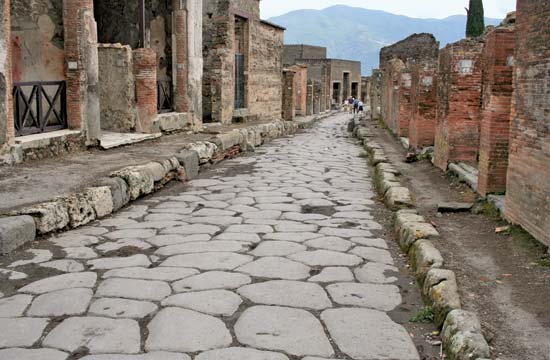

Its invention in 1868
Many great things happened in the UK during the Swinging 60s from the Beatles, to the World Cup in 1966. Maybe the most exciting was the invention of the wheelie bin.
The first bin that we would recognise as a functional modern wheelie bin was invented in March 1968 by the Slough based company Frank Rotherham Mouldings. This simple bin was used primarily to transfer waste across the factory floor.
It stayed in this role until a health and safety inspector in the factory had the idea that this bin was much more efficient but could also improve health and safety and reduce strains and spillages.
Hard work of collecting rubbish prior to 1990s
The full benefits of the efficiencies of wheelie bins were not really realised until the 1980s and the rollout of bins to residential users across the world. The idea of moving back to the old days of heavy iron bins is now almost unthinkable.
The benefits of wheelie bins are of course enhanced by using modern hard-wearing plastic. Old fashioned rubbish bins were made from metal and of course, would be expensive, heavy and likely to rust.
Of course, the bins were also very noisy.
The garbage collectors would certainly have had a workout every day lifting bins to empty them into the truck. In the old days, a garbage truck would move slowly down a street as a team of men ran around emptying bins into it from all directions.
What standard wheelie bin sizes are available?
Through the online waste management shop provided by Waster.com.au, you can see all the wheelie bin sizes available.
[embedded content]
For general waste and cardboard & paper recycling, we currently offer wheelie bin sizes 240 litres, 660 litres and 1100 litres. Note: most bins provided for home usage will be either 120 litres or 240 litres, depending on the waste stream.
The litres refers to the volume of the bin – i.e., 240 litres would contain 240 litres of water when full. Check out our 120-litre and 240-litre bins for secure document disposal.
Check out the images below for standard wheelie bin size comparisons. All bin images are shown next to a woman with a height of 1.65m – the Australian average in 2020.
120-litre wheelie bin sizes
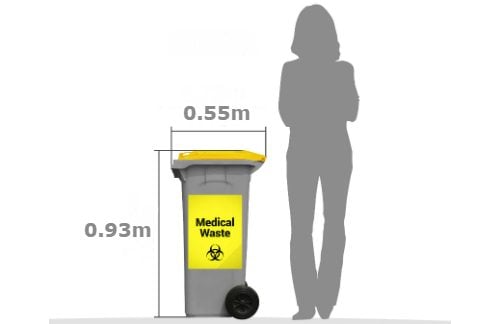

240-litre wheelie bin sizes
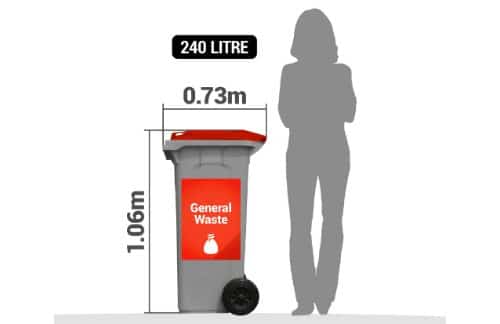

660-litre wheelie bin sizes
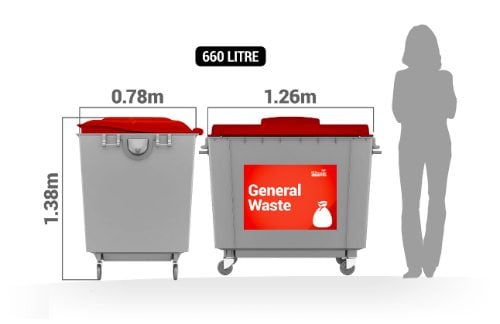

The difference in litres and cubic metres
We have shown pictures on what is commonly regarded as wheelie bins above. These bins are picked up by bin trucks at the back or side of the truck. These are known in waste industry parlance as Rear End Lift or REL.
Larger bin sizes such as 1.5m cubed up to 4.5m cubed are picked up on prongs at the front of the truck.
Smaller wheelie bin sizes are generally measured in litres. Larger bins are generally in cubic metres; a 1.5m bin would be 1500 litres or a 240-litre bin would be 0.24 cubic metres. Basically, multiply metres by 1000 to get to a litres capacity. A special thanks to the metric system for making things easier!
How are varying bin sizes priced?
Smaller bin sizes such as 120, 240, 660 and 1100 litre bins are generally priced on a price per collection basis. For larger bin sizes such as 3m cubed or 4.5m cubed you may hear your supplier talk about rates per metre. You just need to be clear on what the collection charge per bin is and whether there are any hidden costs. Check our article on what to do on bin collection day.
We cover how long it takes to deliver your bin in our article on rubbish bins Melbourne.
Bin sizes Australia: If you are a small (or not so small) Australian business or organisation who needs to organise it’s own commercial waste collection services, you probably have lots of questions such as who is the best provider, what is the best collection frequency for my business and also what is the best bin size to suit my needs and waste streams.
[embedded content]
We will run through in this blog some information on what are the most common sizes of bins for garbage disposal available in the Australian waste management market. Additionally, we will also provide some information on their dimensions and such, which can help you make the right choice for your business.
Arranging bin collections
When arranging bin collections, getting the right bin size at the beginning can save you lots of heartache and expense later on.
The right bin size will mean that you do not have too many collections.
If you get too large a bin, you may then have an infrequent service; you will always have to deal with the smell of rubbish, which is not great in the Aussie summer!
You should also be aware of the space available at your location for bin positioning. For example, residential sites would not be able to have a front lift bin due to health and safety concerns.
If you intend to push the bin to the kerb for collection, the largest bin you could really select is a 660-litre bin size in Australia.
Note: we also covered more detail on the topic in our blog on a small wheelie bin. Discover what is the right size for your business.
Overview of wheelie bin sizes in Australia – standard sizes and dimensions
The waste management and recycling industry in Australia measures bins in volume. Bins are generally standardised sizes to facilitate collection by varying garbage truck systems and equipment.
Smaller wheelie bins are described in litres. The standard small wheelie bins are in sizes 120 litres (0.12 cubic metres), 240 litres (0.24 cubic metres), 660 litres (0.66 cubic metres) and 1100 litres bins (1.1 cubic metres). Remember that one cubic metre is 1000 litres, following the metric system of measurement.
Check out bin sizes below in our image:
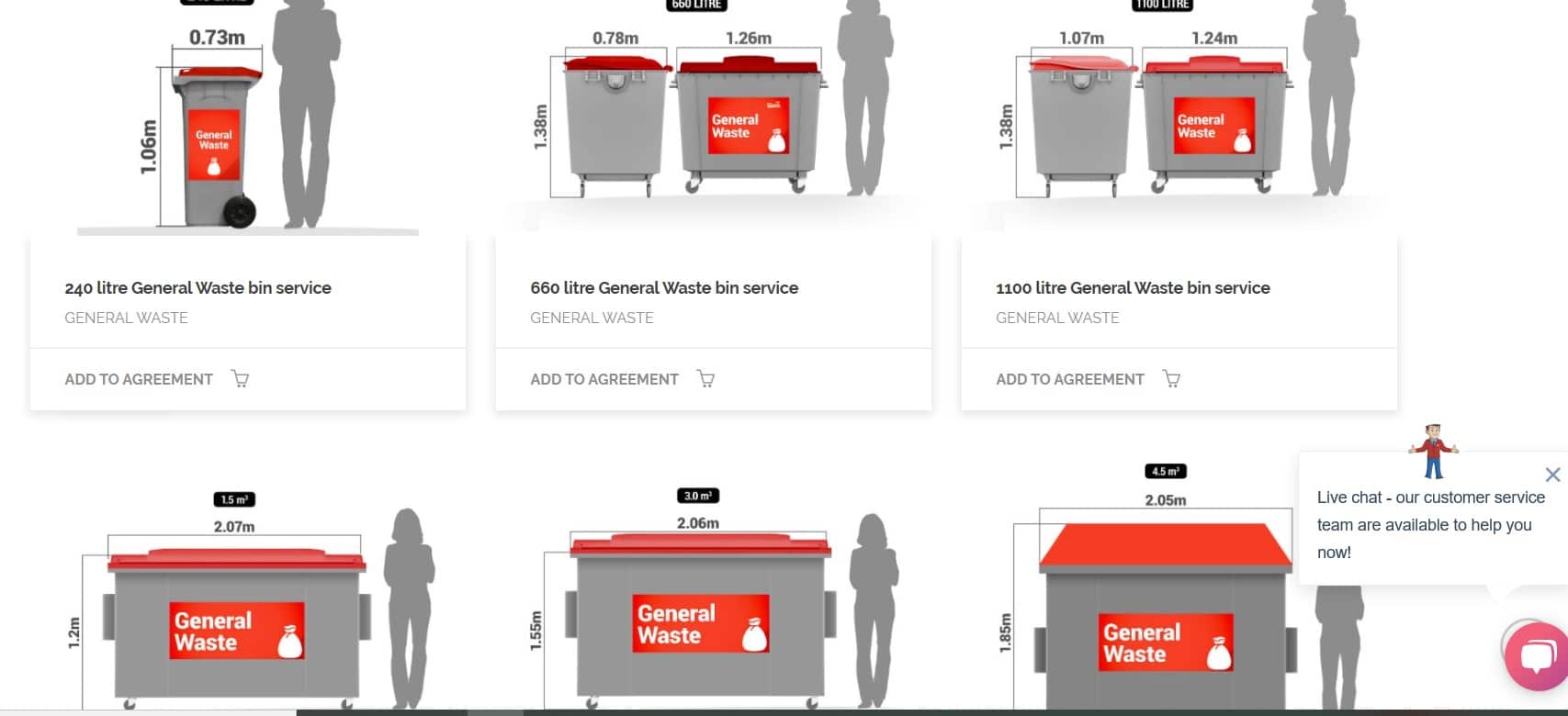

You can check out the exact sizes and dimensions by clicking on the links above. This will let you ascertain your bin fitting into your location and through the door.
For larger bin sizes, the common industry methodology is to use cubic metres. Cubic metre sizes include 1.5m, 3.0m, and 4.5m. A regular garbage truck can easily and efficiently collect these bin sizes.
For larger bin sizes in Australia, we get into the realm of skip bins which can run up to c.30 cubic metres. However, the collection methodology for these skip bins is quite different. The bin will be taken away to be emptied and usually requires a dedicated truck for collection.
Once you know your bin sizes in Australia, what can you do next?
Knowing how much volume of waste and recycling commodities you produce is the basis for starting a proactive waste management plan that can reduce your spend and see a real jump in your environmental performance. Check out an introduction to formulating a waste management plan here. Also, you can take a look at a real-world example (Adelaide recycling) of how a business can reduce costs by implementing smart recycling options.
Check out our services, prices and schedules by clicking on the button below:
Click on this blog on skip bin in Brisbane for construction bins and also waste management recycling for more information.
If you have any questions on the skip bin sizes of a waste management system, access issues in bin collection, and frequencies, please contact us on 1300 927 837.
Please note that when arranging bin hire, you will have your bin delivered in one week.
[embedded content]
Commercial Bins on wheels: when we speak to customers at the start, very often they do not know which size of commercial bins on wheels best suit their business. In today’s blog, we will go through the 6 bin sizes that we provide and what a business should consider before arranging.
We will also cover some info re plastic bags and how they can be removed from your general waste bins
Who is Waster?
Waster provides low cost and flexible commercial bins on wheels and recycling services to small and medium Aussie businesses. Check out our services and prices online by pressing the blue button at the top or bottom of this page.
So, what are the commercial bins on wheels available in Australia?
Let’s look at the 6 sizes of commercial bins that we provide to our small and medium business customers:
Rear lift bins
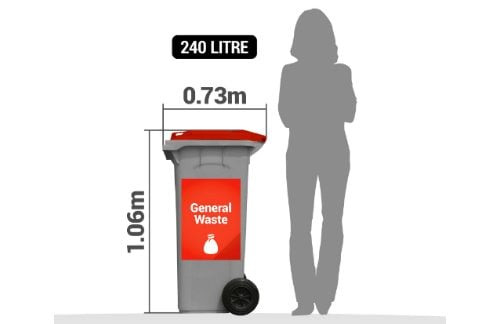

The smallest bin size we provide to commercial customers is the 240-litre wheelie bin as above.
This bin is a plastic wheeled bin and comes on two wheels. It is easy to move around and is most suitable for a small business with limited waste – or alternatively – a business like a cafe that requires smaller regular collections – such as daily. Private homes also use plastic wheeled bins of this size.
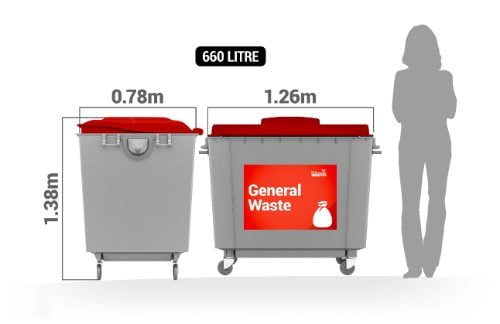

The next size up is a 660-litre wheelie bin. This bin is also of plastic and comes on four wheels.
It is also easy to move around and can be fitted between standard doorposts. It is suitable for slightly larger businesses – or if you have bulkier rubbish.
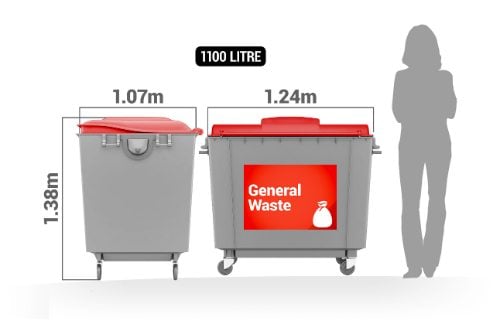

The 1100 litre bin size as above is the largest commercial plastic bin on wheels available. It is also on 4 wheels and easy to move around.
This plastic wheeled bin appears similar to the 660-litre commercial bin when viewed from the front. But, it is deeper front to back and is more “square”. This bin will suit customers who need that extra bin space but do not have enough room for a metal bin.
The commercial bin sizes as above are described as rear lift bins – as they are emptied at the back of the garbage truck.
They are more common in built-up areas – where space is a premium – so will be common in CBDs and smaller business parks, high streets.
Front lift bins
After the 1100 litre bin size – we move up to metal front lift bins (industrial garbage bins on wheels).
Front lift bins are emptied by lifting over the front of the garbage truck.
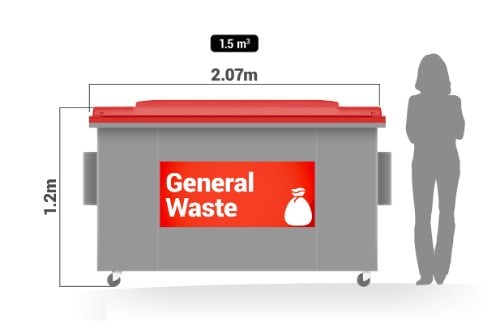

The 1.5 cubic metre or 1500 litres – is the smallest metal bin available.
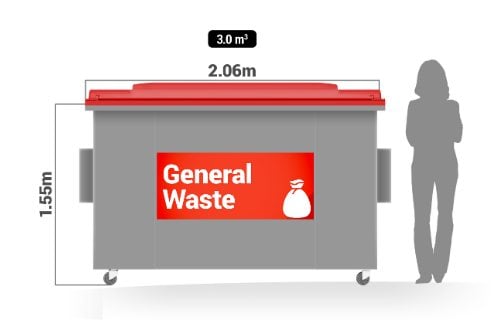

The 3m bin as above is the next size up. It also has a flat lid and can come on wheels or without wheels.
The largest commercial bin on wheels services available is the 4.5m bin as below. Some companies used to offer a 6m3 bin service – but this has almost been completely phased out due to health and safety issues. Note – in some areas – 4.5m bins are not available on wheels due to health and safety. Strong winds can blow these larger industrial bins on wheels, which in turn can concoct a dangerous situation.
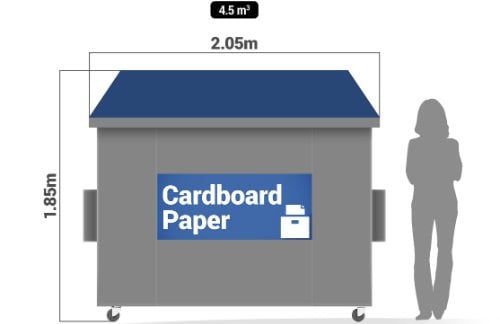

The bin shown above is the cardboard version – i.e. with blue stickers instead of the red for general waste.
This commercial bin size is often not offered on wheels – as due to the large surface area of the bin – it can move around in wind – presenting a safety risk.
General waste bins – can we remove plastic bags from our bins?
[embedded content]
What you should know about plastic bags in commercial bin collections in Australia
One of the most common queries we hear from commercial bins customers is where should we dispose of plastic bags – i.e. can they be recycled or do they have to go into general waste.
There have been great developments in recent years – with innovations such as recycling plastic bags at Coles through REDcycle. Through this system – plastic bags are prevented from entering landfill and are recycled into plastic street furniture. There has also been good news recently whereby Coca Cola has boosted the recycling component of plastic bottles.
Read this article excerpt
An interesting article on Choice.com.au summaries well the impact of plastic bags etc. We quote from the article below:
“Australians send more than a million tonnes of plastic waste to landfill every year, where it will sit for generations as it ever-so-slowly breaks down.”
“In an effort to tackle the growing waste problem, some plastic products are now being made so they break down more readily.”
The article notes that to date – people have focused most attention on shopping bags from supermarkets (estimated that Australian uses an incredible 4 billion per year. Note: some countries like Ireland have put a tax on bag usage and this has dramatically reduced the numbers.
The next big step is making bags and packaging from bio-degradable materials. See our blog on why plastic bags can not go in commingled bins due to contamination concerns.
“In Australia, the term biodegradable usually refers to plastics that are ‘compostable’, meaning they will break down when placed in a home compost bin or commercial composting facility. When disposed of correctly, a compostable plastic will almost completely biodegrade within six months – a big improvement on the 100-plus years it would take for something like a normal plastic bag to break down in landfill.”
Of course, things are never as simple as you would hope:
“If the plastic is labelled ‘home compostable’, then it can go in your home compost bin. But the majority of products currently available are labelled ‘compostable’, meaning they need to go to a commercial composting facility, where they get treated with high temperatures to create an organic-rich soil that can be on-sold.”
See our blog on packaging alternatives to plastic.
Things to remember
We have covered the impact that plastic has on the ocean and seas in our blog in national resource recovery.
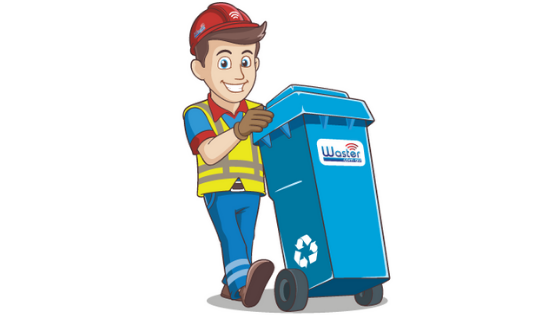

The article also gives a handy listing:
“Look for these terms:
- Biodegradable will biodegrade, but generally not as quickly as compostable plastic. Look for products that state they are 100% biodegradable and show the disposal method.
- Compostable will biodegrade in a commercial compost facility. Look for the Australian Standard number (AS 4736-2006) on the label.
- Home compostable is the best option if you have a home compost bin. Look for the Australian Standard number (AS 5810-2010) on the label.”
Also, check out our blog on how to recycle bottle and cans. On a similar topic, also check out our blog on how much waste Australians produce in Integrated waste services.
See blog on new ABC TV services War on Waste – rubbish removals. See our blog on rubbish collection Brisbane and a new program for recycling.
Small wheelie bin
If you are considering what size of wheelie bin is right for your business whether it is in Adelaide, Perth, Sydney etc, we will help you make the right choice in this article.
Picking the right bin size, whether it is a small wheelie bin or a large dumpster rental, is vital as a step to boosting recycling and saving your business money.
We will quickly run through the wheelie bin sizes available on the Australian waste market and provide some images with dimensions and measurements etc.
Waster, an online waste management business, dedicates itself to delivering the lowest costs, best service and flexible waste service agreements to small and medium-sized business clients throughout Australia. We operate in all major Australian cities including Sydney, Melbourne, Brisbane, Perth, Adelaide, Canberra, Darwin, Gold Coast, Hobart, Newcastle etc.
You can find out all about us here and check out our all-inclusive, low-cost service offering here. Check out an article on larger bin sizes in skip bin hire Newcastle.
What small wheelie bin sizes are available?
Through our online waste management shop provided, you can see all the wheelie bin sizes Australia available. For General Waste and Cardboard & Paper recycling, we currently offer wheelie bin sizes 240 litres, 660 litres and 1100 litres.
Note: most bins provided for home usage will be of either 120 litres or 240 litres depending on the waste stream. Local councils are progressively trying to decrease the size of general waste bins available for residents to increase recycling and decrease their costs.
In 2020, it is increasingly common for councils to be decreasing the small wheelie bin size for general waste to only 80 litres (i.e., a third of the standard 240-litre wheelie bin size).
This small wheelie bin size is not available for commercial collections – i.e. the smallest wheelie bin size that we provide for commercial collections is the 240-litre wheelie bin – which is c. 1.06 tall.
The litres refers to the volume of the bin i.e. 240 litres would contain 240 litres of water when full. Check out our 120-litre and 240-litre bins for secure document disposal.
Does your council provide the service? – they often do for small bins
A number of councils (though decreasing) continue to provide collections of smaller wheelie bins for commercial businesses (commercial wheelie bin sizes) and organisations. This is certainly not as prevalent as it used to be and is being phased out in a number of areas.
You should investigate if this service is available to you, as it may be significantly cheaper than can be provided by commercial waste companies.
Use on-site wheelie bins – rosette lids etc
You may be planning on utilising smaller wheelie bins for on-site usage – i.e. if you operate a large site such as a school, hospital, convention centre or hotel. It is common to empty the smaller bins into larger bins such as 3.0 cubic metre or 4.5 cubic metre bins for collection as this is more efficient and reduces collection cost.
Waster can help you with numerous additions to use on-site bins such as rosette lids (see below) to help meet your onsite needs.
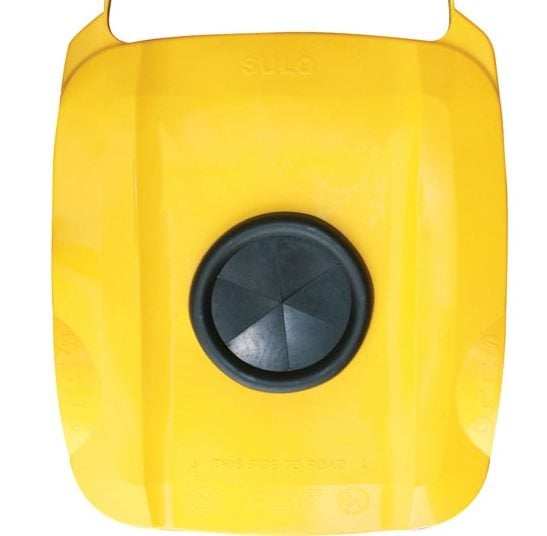

Bin lifters and tipplers
Waste can provide bin lifters and tippler machines to facilitate emptying small wheelie bins into larger bins for collection. This can be extremely useful on-site. It can reduce injuries, as well as spilled garbage around the facility. Furthermore, it can also significantly reduce time requirements.
Bin enclosures
If you have your small wheelie bin sizes in public areas – you may wish to consider a bin enclosure – you can see examples at the website linked here.
This sort of bin enclosure can provide a strong and appealing visual look to your small wheelie bin position and can boost recycling.
Inside office small wheelie bin size
For bins to be positioned inside your office – we would recommend you visit Method Recycling – an Australian business that manufactures high-quality small wheelie bin sizes for inside offices etc.
[embedded content]
These bins would be emptied into larger wheelie bins or dumpster-style bins by your cleaning staff for collection by the rubbish truck.
Next steps re small wheelie bin sizes in Australia
Jump on our online shop to access low prices and flexible 3o day agreements for all your waste streams and small wheelie bin needs.
We also answer questions such as what is general waste.
One of the first signs of modern society that we see in tv shows is the invention of the wheel. It is, of course, funny – and amazing that plastic wheeled bins are a pretty new invention (really only becoming widespread in Australia from the 1980s).
It is a bit like the invention of wheeled suitcases – and how no one was able to think of them before!
In today’s blog – I intend to cover the various sizes of plastic wheeled bins that you can choose. I will also cover some of the pros and cons of each bin for various businesses.
You should probably know a lot by now after reading to make the right bin size choice for your business.
Waster helps small businesses like you
At Waster – we work with small and medium Aussie companies to help you boost recycling and reduce costs. You can easily check out all your wheeled bin size options and services online by clicking the button below.
Our contracts are on a 30-day basis – so you never need to worry about lock-in contracts or rollover clauses again.
What type of plastic wheeled bin is right for you and your business?
If you are looking for the right size of bin for your commercial requirements, we can guide you in the lines below.
In the world of bins, commercial bins in Australia fall into two categories. The categories are metal bins (industrial garbage bins) and plastic wheeled bins.
Plastic wheeled bins – better for smaller businesses of when constrained for space
If you are a small business or new business – a plastic bin on wheels (2 or 4 wheels) is likely the right option for you. Commercial waste collection companies in Australia generally offer services in the bin sizes as below:
240-litre wheelie bin – two-wheeled bin – standard large wheelie bin size for homes
Plastic makes up this bin. The two larger bins also feature 4 wheels. You can see images of the bins as linked above.
Benefits of these bins are that they are relatively light and easy to move around. The other benefits for you are that they decrease sound when being collected – i.e. quieter than a metal bin.
A plastic bin can also keep smells inside and any rodents, fruit fly outside etc if you are handling food and in a warm climate region.
What sort of businesses would use these smaller bins?
These bins are suitable for smaller businesses such as offices, smaller cafes etc or businesses with limited space.
Smaller commercial garbage bin sizes may be suitable if you are based in a built-up area such as a CBD. Larger bins will be difficult to collect. This is due to health and safety concerns due to passers-by etc and lifting a bin overhead.
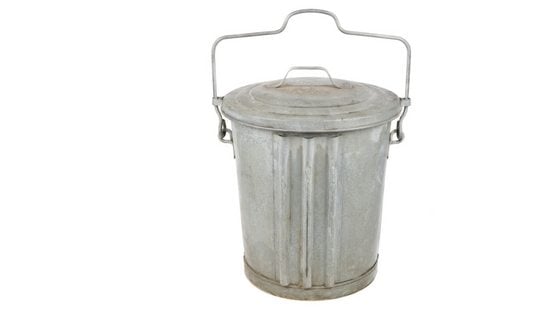

Additionally, if you have a restaurant or cafe, you will want your waste collected more frequently.
If you require a larger bin
If these bins are not large enough for your business needs – you can look at a larger metal bin size.
We can provide regular bin services in industrial metal garbage bins as per the three size options below:
These bins are larger metal bins and can come on wheels or not wheels. The bin may not require wheels if you move it around on site via forklift. Additionally, the bin does not need wheels if it does not need moving.
These commercial trash bin sizes are more suitable for larger businesses with regular waste requirements.
If waste is very heavy, a larger bin may also be required. Smaller plastic bins can not take the excessive weight.
The next bin size up
If these commercial garbage bin sizes are too small for you, the next option is using a skip bin. The difference with a skip bin is that it is delivered and removed from the site each time. Smaller bins are emptied by a rubbish truck. Hence, you do not need to remove them each time.
We ask: can see-through wheelie bins boost recycling?
When we put stuff in the garbage cans or wheelie bins (whatever you want to call it), it is almost as if it is forgotten. No one is going to look at your bin because (a) it is smelly and (b) because it is very difficult.
Some businesses, as well as councils, are trialling see-through plastic bins as a way to check that people are not contaminating their recycling bins.
This is particularly important as some councils are considering phasing out their commingled recycling services due to contamination issues and also the difficulty in exporting mixed recycling to China.
As you will know from reading our blogs, the Chinese outlet for recycling has closed as China is clamping down on low-quality recycling.
Considerations
To date, wheelie bins have been made from dark plastic. So, knowing if garbage is in the recycling bin is very difficult.
Numerous councils have considered fining residents if their bin is contaminated.
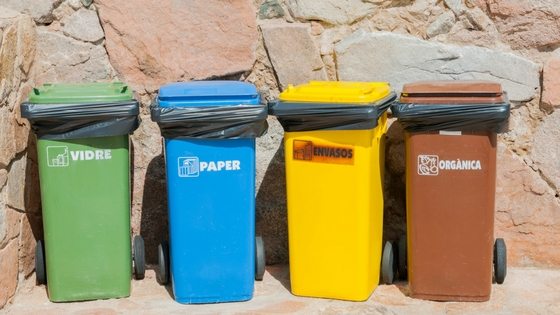

With the current crisis in Australian recycling, ensuring that recycling is of high quality has never been more important.
The ABC reports that a council in Western Australia is trialling see-through garbage cans in this area:
“Mindarie Regional Council in Western Australia is hoping to challenge by putting wheelie bin contents on display.”
“The MRC is WA’s largest waste management authority and collects 250,000 tonnes of waste and recyclable material from Perth’s northern suburbs.”
“There are no plans to put all residents’ rubbish on display, just 20 transparent bins will be used by participating houses over eight weeks.”
Are there any bad impacts of this plan for clear garbage cans?
Some residents have voiced concerns that these see-through garbage cans could be an invasion of privacy. Nosy neighbours might check how much people drink or what they throw out.
It is also argued that neighbours may social shame people who do not treat recycling correctly.
Some other people have also raised valid concerns about identity theft. They raised the idea that criminals could drive down streets and see when a household has thrown out lots of paperwork.
In the future
We will be very interested to see what the outcome of this trial is regarding see-through wheelie bins or garbage cans. Is it beneficial or detrimental?
We will keep you updated.
See a video that tackles this:
[embedded content]
Contact us!
If you have any questions about the best bin size for your business, simply contact Waster and we will talk you through the options and variations.
We look forward to speaking with you!




